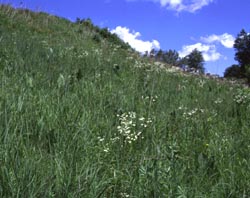
 |
"No," she said. There is no sea here. But the land rolls a little like the sea." -from Patricia MacLachlan's Sarah Plain and Tall |
|
| Jim Edgar, Panther Creek State Fish and Wildlife Area |
"Jethro regretted the melting of that glacier; if it could have hung on another hundred miles, life might have been very different for him and his family."
-from Irene Hunt's Across Five Aprils
The foundation, rock and soil, upon which prairies are located, is an important part of the prairie ecosystem. This foundation shapes the appearance of the landscape and provides favorable conditions for a variety of vegetation.
The difference in the landscape of Illinois is drastic from the north to the south. Southern Illinois has many hills, forests, and soil not suited for growing many crops. The glaciers visited central and northern Illinois, leveling the land and depositing rich soil in some areas. The glaciers that moved through Illinois long ago--200,000 to 18,000 years ago--created excellent conditions for prairies.
Advancing glaciers picked up debris, including sand, gravel, and large boulders. Then, they carried these materials across the landscape. They moved with them rocks stripped from bedrock surfaces and anything else in their path. A mixture of the sand, clay, and boulders picked up by the glacier was deposited as the ice advanced and retreated. This debris, known as glacial drift, was deposited in different ways, each leaving a characteristic mark on the landscape. Material deposited in a ridge in front of a glacier is called an end moraine.
Meltwater streams from glaciers also deposited debris. They deposited heavier rocks, gravel, and sands near the edge of the ice. The water carried the finer clays and silts downstream.
Winds carrying fine silt (loess) from meltwater streambeds moved materials great distances from the glacier. This also helped to create the fertile soils of Illinois.
(Read) A Hillsboro Prairie Beacon newspaper column from 1838 has an eye-witness account of the appearance of the an end moraine.
|
|
Copyright © 2000 Illinois State Museum